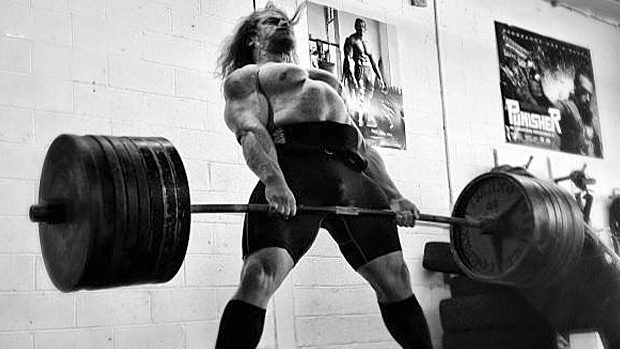Lifters who are stuck when it comes to strength or muscle gains usually do one of two things:
- They program hop (switch to another plan without finishing the previous one).
- Or they stick to their favorite program with eternal faith that their plateau will end eventually... if they just do the same stuff harder.
But program-hopping is for rookies, and sticking to the same program forever is a mug's game. A better option? Use proven progression strategies.
To do what you've never done before, you must adapt. But you won't see progress if you're so adapted that nothing happens. Want to finally make progress with your workouts and grow over the long haul? Build strength no matter the routine.
Many of the most successful training programs of all time, such as Bill Starr's 5x5, are built on a linear progression model and progressive overload. The effectiveness of such programs is irrefutable.
If you want to get stronger, you need to progressively push yourself in the gym. If you want to build muscle, you need to progressively push yourself in the gym. Plain and simple. But even chasing progressively bigger weights each set has its limits.
Let's use the 5x5 program as our reference point. Let's say when you first started the program, you were bench pressing 150 pounds for 5 sets of 5 reps. You've consistently executed the program, increasing your working sets (5x5) by 5 pounds every week for 2 months, and at that point, you reached 200 pounds.
Can you expect to continue to see the same results on this program? After all, it seems pretty foolproof at this point, doesn't it? Well, the problem is 5 sets of 5 reps gets increasingly difficult the stronger you get. Soon, in order to get your 5x5, you aren't taking 2-minute breathers between sets anymore. You're taking full-on lunch breaks.
You fall short on reps that you should be crushing. As a result, you become discouraged because your program says you should see consistent gains, but common sense tells us a 5x5 of 300 pounds is going to require more adaptation than doubling up on Spike®, loading up a barbell, and giving it hell for your Instagram account.
So, is continuing on this route for the sake of consistency the smart way to lift? Sure, persistence is good and admirable, but you must adopt new strategies to create new levels of success.
In a recent study, researchers examined the effects of three different resistance training volumes on maximal strength for the snatch, clean and jerk, and squat during a 10-week training period. The participants included 51 trained junior lifters with at least three years of training experience. The competitors were randomly divided into three groups:
- Low-Volume Group
- Moderate-Volume Group
- High-Volume Group
All of the subjects trained 4-5 days per week with a periodized routine using the same exercises, intensities, and routines. The only variable was the total number of sets and reps at each relative load:
- Low-Volume Group (1,923 reps)
- Moderate-Volume Group (2,481 reps)
- High-Volume Group (3,030 reps)
Here's how the study fared:
- Low-volume group improved in the clean and jerk by 3.7% and the squat by 4.6%.
- Moderate-volume group improved in the clean and jerk by 3.7%, squat by 4.2% and the snatch by 6.1%.
- High-volume group improved in the clean and jerk by 3% and the squat by 4.8%.
The moderate-volume group showed higher strength gains than the low-volume group and high-volume group. However, there were no significant differences between the LVG and HVG training volume-induced strength gains.
The study concluded, "The present results indicate that junior experienced lifters can optimize performance by exercising with only 85% or less of the maximal volume that they can tolerate. These observations may have important practical relevance for the optimal design of strength training programs for resistance-trained athletes since we have shown that performing at a moderate volume is more effective and efficient than performing at a higher volume." (1)
When you've reached a strength plateau under a program like 5x5 protocol you may need to take one step back in order to take two steps forward. Unfortunately, most lifters don't have the long-term perspective to see this, and instead, abandon a program entirely.
At the same time, loading the same barbell with the same weight as you did last week and hoping you got stronger this week isn't a viable way to improve your numbers. So let me introduce a technique to help you blast through sticking points and get stronger.

This involves ascending and descending loads. This method requires your working sets to ascend to a peak load and descend afterward, like the shape of a pyramid (duh).
During the ascent to your peak load, you'll prime your nervous system while also preserving it for the top end set. After this peak set, you'll decrease the load on the bar and increase your reps yet again to induce greater metabolic stress, leading to faster muscle growth.
With the pyramid method, you'll gradually ramp up from 40-60% of your max towards 80% to your 1RM. This technique will help you in two ways: Physically and mentally.
1. Physically
While lifting lighter weights you'll move more explosively.
This will help you develop power along with intramuscular coordination. Intramuscular coordination is the ability of your muscles to fire together more effectively.
By using multiple loads across the force-velocity curve, we're able to improve intramuscular coordination. In time, this teaches the nervous system to recruit fewer motor units for the same relative intensity.
Using the same lift for multiple sets will also improve intermuscular coordination, the firing of muscle groups working together in a specific movement at specific joint angles. In other words, you're greasing the groove.
2. Mentally
You'll build the confidence to crush each load and the reps as called for.
Since you're ramping up to a heavier weight and using fewer reps, it'll feel easier as it gets harder. And the subsequent descending sets will feel lighter, allowing you to optimize the quality of each rep.
Compared to a linear progressive model where your last set is heaviest, pyramid rep schemes allow you to autoregulate your training, an essential skill for the advancing lifter. While it sounds hardcore and logical to slog through a workout and stick to perfect percentages and a linear model, getting stronger sometimes requires a different approach.
Pyramid training gives you the ability to hit your heavy sets earlier in a workout when you're fresher, meaning better rep quality and fewer missed lifts. Secondly, if you nail your heavier sets early on, you have the flexibility to stay heavier with subsequent sets, doing more work overall.
Let's break it down more simply by looking at total work completed, the sum of all sets and reps for a given exercise or workout. This is a comparison between the two methods:
Pyramid Progression 5x5
- 225x5
- 255x5
- 275x5
- 265x5
- 255x5 (Feeling good, stay heavier)
- Total Work: 1125 + 1275 + 1375 + 1325 + 1275 = 6,375 pounds lifted.
At the end of the day, total load and improved rep quality win out. When your go-to linear progression model clunks out, it's time to adopt a new strategy. In this case, pyramids may be your best option.
- González-Badillo, J J, et al. "Moderate Resistance Training Volume Produces More Favorable Strength Gains than High or Low Volumes during a Short-Term Training Cycle." Advances in Pediatrics., U.S. National Library of Medicine, Aug. 2005
- Lacerda, L T, et al. "Variations in Repetition Duration and Repetition Numbers Influence Muscular Activation and Blood Lactate Response in Protocols Equalized by Time Under Tension." Advances in Pediatrics., U.S. National Library of Medicine, Jan. 2016.





